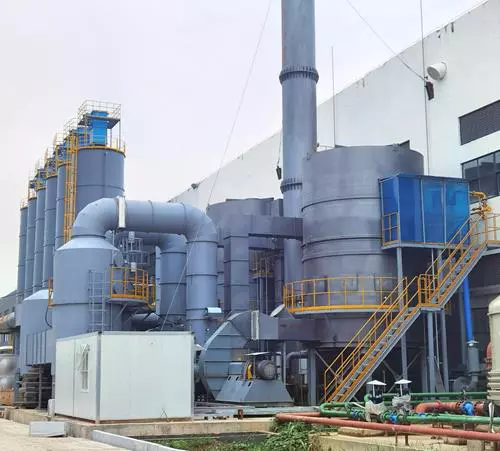What are the maintenance requirements for a recuperative thermal oxidizer?
介紹
Recuperative thermal oxidizers are essential equipment in various industries for controlling air pollution. To ensure their optimal performance and longevity, regular maintenance is crucial. This article will explore the maintenance requirements of a recuperative thermal oxidizer from multiple aspects, providing detailed explanations and insights.
Daily Maintenance
– Inspect the oxidizer’s temperature and pressure gauges to ensure they are within the specified range.
– Check for any abnormal noises, vibrations, or leaks in the system.
– Verify the proper functioning of the burner and igniter.
– Clean the filters regularly to prevent clogging and maintain airflow.
– Monitor the exhaust stack emissions to ensure compliance with environmental regulations.
Weekly Maintenance
– Inspect and clean the heat exchangers to remove any accumulated dirt or debris.
– Lubricate the fan motor bearings to maintain smooth operation.
– Check the condition of all electrical connections and wiring.
– Inspect and clean the combustion chamber walls and burner nozzles.
– Verify the operation of safety devices, such as pressure relief valves and flame sensors.
Monthly Maintenance
– Perform a thorough inspection of the control panel and electrical components, addressing any issues promptly.
– Clean the burner assembly and adjust the flame to optimize combustion efficiency.
– Inspect and clean the preheater and post-heater tubes.
– Test and calibrate all temperature and pressure sensors.
– Verify the accuracy of the flow meters and adjust if necessary.
Annual Maintenance
– Conduct a comprehensive inspection of the entire system, focusing on heat exchangers, valves, and fans.
– Inspect and clean the ductwork, removing any accumulated dust or debris.
– Replace worn-out or damaged components, such as gaskets, seals, or insulation.
– Perform a complete system performance check, including efficiency and emissions testing.
– Schedule professional service for a detailed evaluation and potential repairs.
結論
Regular maintenance is essential for the optimal performance and longevity of a recuperative thermal oxidizer. By following a comprehensive maintenance schedule, including daily, weekly, monthly, and annual tasks, operators can ensure the system operates efficiently and complies with environmental regulations. Investing time and effort in the maintenance of this critical equipment will result in improved air quality and a safer industrial environment.

公司簡介
We are a high-tech enterprise specializing in the comprehensive treatment of volatile organic compounds (VOCs) emissions and carbon reduction energy-saving technologies. With our core technologies in thermal energy, combustion, sealing, and automation, we have the capabilities in temperature field simulation, air flow field simulation modeling, ceramic heat storage material performance, molecular sieve adsorption material selection, and VOCs high-temperature incineration oxidation testing.
團隊優勢
Our RTO technology research and development center and waste gas carbon reduction engineering technology center are located in Xi’an, while our 30,000 square meter production base is in Yangling. As a leading manufacturer in RTO equipment and molecular sieve rotary equipment, our core technical team comes from the Aerospace Liquid Rocket Engine Research Institute (Aerospace Sixth Institute). We currently have over 360 employees, including more than 60 R&D technical backbones, 3 senior engineers at the researcher level, 6 senior engineers, and 115 thermodynamics PhDs.
核心產品
Our core products include the Rotary Valve Heat Storage Oxidation Furnace (RTO) and molecular sieve adsorption concentration rotor. Combining our expertise in environmental protection and thermal energy system engineering, we provide customers with comprehensive solutions for industrial waste gas treatment, carbon reduction, and thermal energy utilization for various operating conditions.
認證、專利和榮譽
- 智慧財產權管理系統認證
- 品質管理系統認證
- 環境管理系統認證
- 建築業企業資質
- 高新技術企業
- Patent for Rotary Valve Heat Storage Oxidation Furnace
- Patent for Rotary Rotor Heat Storage Incineration Equipment
- Patent for Disc Molecular Sieve Rotor

選擇合適的 RTO 設備
- 確定廢氣的特性
- 了解當地法規和排放標準
- 評估能源效率
- 考慮維
- 預算和成本分析
- 選擇合適的RTO類型
- 考慮環境和安全因素
- Performance testing and validation
Understanding the composition, flow rate, and temperature of the waste gas is crucial in selecting the appropriate RTO equipment.
Complying with local regulations and emission standards ensures regulatory compliance and environmental protection.
Assessing the energy consumption and heat recovery capabilities of the RTO equipment helps maximize energy efficiency.
Taking into account factors such as ease of operation, maintenance requirements, and availability of spare parts is essential for smooth operation and cost-effective maintenance.
Analyze the initial investment, operational costs, and potential savings to determine the overall cost-effectiveness of the selected RTO equipment.
Choosing between different types of RTOs, such as single-chamber or multi-chamber, depends on the specific needs and characteristics of the waste gas.
Environmental considerations include noise levels, emission reduction efficiency, and potential byproduct emissions. Safety factors include explosion protection and fire prevention measures.
Conducting performance tests and validation ensures that the selected RTO equipment meets the required standards and performance expectations.

服務流程
- Consultation and evaluation
- Design and solution development
- Production and manufacturing
- Installation and commissioning
- After-sales support
Initiate the inquiry, conduct on-site visits, and analyze the customer’s requirements.
Create customized designs and perform simulation modeling to develop suitable solutions. Conduct solution reviews.
Manufacture the equipment according to the specific requirements, ensure quality control, and perform factory testing.
Carry out on-site installation, conduct commissioning and operation tests, and provide training services.
Provide regular maintenance services, technical support, and supply spare parts to ensure long-term performance and customer satisfaction.
We are a one-stop solution provider with a professional team dedicated to tailoring RTO solutions for our customers.
作者:米婭
